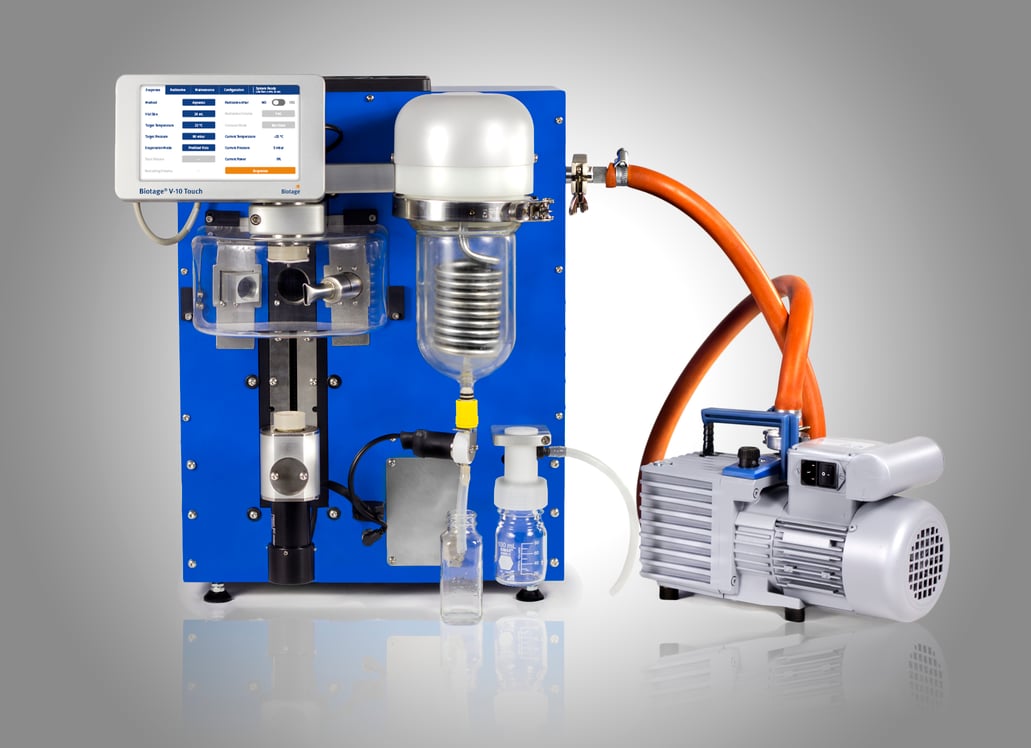Have you ever been faced with the challenge of evaporating solvent from a reaction mixture where the target compound and perhaps some by-products are temperature sensitive and degrade or decompose with elevated heat? How do you efficiently accomplish this evaporation challenge?
In a discussion with some chemists recently this was the challenge they frequently encounter. So, I thought it to be a good post topic.
This issue is especially problematic if the solvent requiring evaporation has a high boiling point (≥ 100 °C). The chemists who mentioned this issue said they need to evaporate solvents such as DMSO, DMF, and sometimes water at temperatures no higher than 30 °C to avoid compound decomposition.
Since rotary evaporation does not efficiently evaporate these solvents at this reduced temperature, they resort to extractions, where possible, adding complexity, potential yield losses, and inefficiency to their workflow.
Intrigued by their quandary, I wondered if our Biotage® V-10 Touch was up to the challenge, Figure 1. For those of you not familiar with this automated solvent evaporator, it was designed to efficiently evaporate almost any solvent using a combination of
- -High speed vial rotation (6000 rpm)
- -Vacuum
- -Heat
 Figure 1. Biotage® V-10 Touch rapid solvent evaporator.
Figure 1. Biotage® V-10 Touch rapid solvent evaporator.
Back to the original issue – can DMSO, DMF, and water be fully evaporated at 30 °C and, if so, how much time is required? Well, the V-10 Touch also has eight editable pre-programmed methods designed to efficiently evaporate virtually any solvent. Each method has its own vacuum and temperature “gradient” going from ambient to the targets in order to minimize the chances of solvent bumping.
With that as the backdrop, under default operating conditions, these three solvents evaporate at rates around 1 mL/min, Table 1.
Table 1. Evaporation rates using default V-10 Touch settings.
| Solvent | Method | Target temp. (°C) | Target vac. (mbar) | Evap. rate (mL/min) |
| DMF | Hi Boil | 48 | 0 | 1.14 |
| DMSO | Very Hi Boil | 56 | 0 | 1 |
| H2O | Aqueous | 46 | 8 | 0.84 |
For the experiments, I set all evaporation targets to 30 °C and kept the same target vacuum. For DMSO, I did edit the method changing it from an auto sensing finish to a timed, 25 min finish. As expected, evaporation times at 30 °C were longer but, with the exception of DMSO, the differences were not large, Figure 2.
Table 2. Evaporation rates at 30 °C.
| Solvent | Method | Target temp. (°C) | Target vac. (mbar) | Evap. rate (mL/min) |
| DMF | Hi Boil | 30 | 0 | 1 |
| DMSO | Very Hi Boil | 30 | 0 | 0.34 |
| H2O | Aqueous | 30 | 8 | 0.65 |
Why does low temperature evaporation work? By spinning the evaporation vial at high speed (6000 rpm), the solvent is spread uniformly on the vial’s walls increasing its surface area contact with both the vacuum and heat while thinning the solvent volume/square cm. If you have familiarity with thin-film evaporation systems, the V-10 Touch works with similar principles.
So, we now know that solvents such as water, DMF, and DMSO with high boiling points can be efficiently evaporated at 30 °C allowing recovery of dried, temperature sensitive compounds without heat-generated degradation.
If you are interested in learning more about high-speed solvent evaporation, visit our V-10 Touch Evaporation System's Brochure page!

 Organic Workflow
Organic Workflow Peptide Workflow
Peptide Workflow Scale-Up Flash Purification
Scale-Up Flash Purification  Sample Preparation
Sample Preparation Biomolecule Purification
Biomolecule Purification Oligo synthesis
Oligo synthesis Scavengers and Reagents
Scavengers and Reagents Service & Support
Service & Support Accessories & Spare parts
Accessories & Spare parts Investors
Investors Reports & News
Reports & News The Share
The Share Corporate Governance
Corporate Governance Calendar
Calendar Sustainability
Sustainability Our Offering
Our Offering Our History
Our History Our Locations
Our Locations Leadership
Leadership